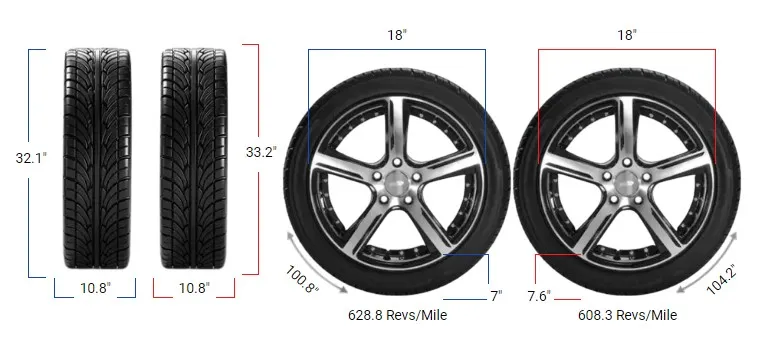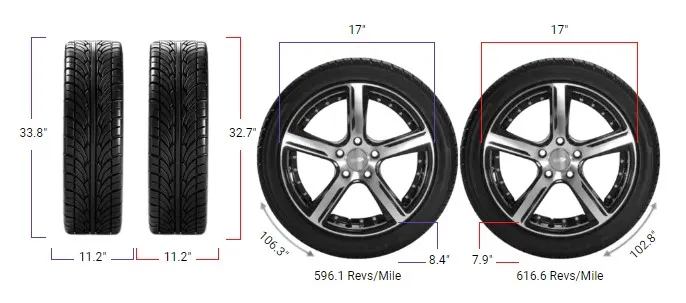Tire Size 175/80r13 vs 185/80r13

Switching tire sizes can seem complicated, but it doesn’t have to be. Let’s break down how moving from 175/80R13 to 185/80R13 impacts your driving experience and what you should consider before making the change.
- The wider 185/80R13 tires provide better stability and grip during cornering.
- Slightly increased ground clearance enhances vehicle performance on uneven surfaces.
- The wider tires may reduce fuel efficiency due to higher rolling resistance.
- Larger sidewalls on the 185/80R13 tires improve ride comfort by absorbing bumps.
- Aesthetic changes offer a sportier and more aggressive stance for the vehicle.

Fitment Guide
It’s essential to stay within a 3% difference in overall tire diameter to maintain proper fitment. In this case, the diameter difference between 175/80R13 (24.02 inches) and 185/80R13 (24.65 inches) is 2.6%, which falls within the acceptable range.
This means the switch is feasible without requiring significant adaptations to your vehicle. However, if the difference exceeded 3%, rubbing or clearance issues might occur, especially during turns or when the suspension compresses.
On-Road Impact
The slightly larger diameter and increased width contribute to better grip and stability, particularly during cornering and at higher speeds.

This can improve overall ride comfort and makeover adds 0.63 inches to the height, slightly raising ground clearance, which can be beneficial when driving over bumps or uneven surfaces. However, this increase is minor and may not drastically affect most the vehicle feel more grounded.
- Ground Clearance: A small increase in diameter on-road situations.
- Gas Mileage: With wider tires, rolling resistance increases, meaning the engine needs to work harder to maintain speed. This could result in a slight drop in fuel efficiency, but the difference is often negligible for most daily drivers.
- Aesthetic Look: The wider 185/80R13 tires tend to give the vehicle a more aggressive stance, appealing to those who want their car to appear sportier. The subtle change in size can enhance the vehicle’s overall appearance without dramatically altering its design.
- Ride Comfort: The larger sidewall height on the 185/80R13 provides a cushioned feel, which can improve ride comfort by absorbing more road imperfections. For drivers who prioritize a smooth ride, this could be a noticeable benefit.
- Speedometer Accuracy: The diameter difference between the two tire sizes affects your speedometer readings. With 185/80R13 tires, your speedometer will read slightly slower than your actual speed—at 20 mph, your real speed would be 20.52 mph. While this difference is minor, it’s essential to keep it in mind.
Off-Road Impact
Off-road, the differences between the two tire sizes become more evident. Wider tires like the 185/80R13 provide better traction, making them a better choice for uneven or slippery surfaces such as dirt, mud, or gravel.

The added width gives more surface contact, allowing for better grip and control.
- Ground Clearance: The small increase in ground clearance can prove helpful on rocky or uneven terrain. While 0.63 inches may not seem like much, every bit of clearance helps when off-roading.
- Durability & Wear: Wider tires tend to distribute the vehicle’s weight more evenly, reducing the likelihood of uneven wear. The 185/80R13 tires, with their increased contact patch, can handle off-road stress better, offering enhanced durability. However, the wider tire also means more exposure to sharp rocks or debris, increasing the chance of cuts or punctures.
- Ride Comfort: Off-road drivers will appreciate the added cushioning provided by the larger sidewall of the 185/80R13 tires. This can help absorb impacts from rough terrain, making off-road adventures smoother.
175/80r13 vs 185/80r13 Chart
| Feature | 175/80R13 | 185/80R13 | Difference |
|---|---|---|---|
| Diameter inches (mm) | 24.02 (610.2) | 24.65 (626.2) | 0.63 (16) +2.6% |
| Width inches (mm) | 6.89 (175) | 7.28 (185) | 0.39 (10) +5.7% |
| Circumference inches (mm) | 75.47 (1917) | 77.45 (1967.27) | 1.98 (50.27) +2.6% |
| Sidewall Height inches (mm) | 5.51 (140) | 5.83 (148) | 0.31 (8) +5.7% |
| Revolutions per mile (km) | 839.51 (521.65) | 818.06 (508.32) | -21.45 (-13.33) -2.6% |
| Speedo Reading | 20 mph (32.19 km/h) | 20.52 mph (33.03 km/h) | +0.52 mph (+0.84 km/h) |
Difference Between 175/80R13 and 185/80R13
The main difference between 175/80R13 and 185/80R13 tires is their width and overall diameter. The 185/80R13 tire is 10 mm (0.39 inches) wider and has a diameter that’s 16 mm (0.63 inches) larger, resulting in a 2.6% increase over the 175/80R13.
Can I Use 185/80R13 Instead of 175/80R13?
Yes, you can use 185/80R13 tires instead of 175/80R13. The overall diameter difference is approximately 2.6%, which is within the acceptable limit of 3%. This means the swap should not significantly affect your vehicle’s performance.
How Much Taller Is a 185/80R13 Tire Than a 175/80R13?
A 185/80R13 tire is about 16 mm (0.63 inches) taller in diameter than a 175/80R13 tire. This represents a 2.6% increase in overall diameter.
How Much Wider Is a 185/80R13 Tire Than a 175/80R13?
A 185/80R13 tire is 10 mm (0.39 inches) wider than a 175/80R13 tire, which is a 5.7% increase in width.
Our Observation
Switching from 175/80R13 to 185/80R13 offers several benefits, particularly in stability, traction, and ride comfort.
On-road, the wider tire size enhances stability and grip, making the car feel more secure during everyday driving. The slight reduction in fuel efficiency and minor speedometer discrepancy are negligible for most drivers.
Off-road, the improved ground clearance and traction make the 185/80R13 a better choice for those who often encounter rough terrain.
However, the increase in tire width may expose the tire to more wear in challenging environments. Overall, the switch is beneficial for drivers looking for a balanced improvement in both on-road and off-road performance.



